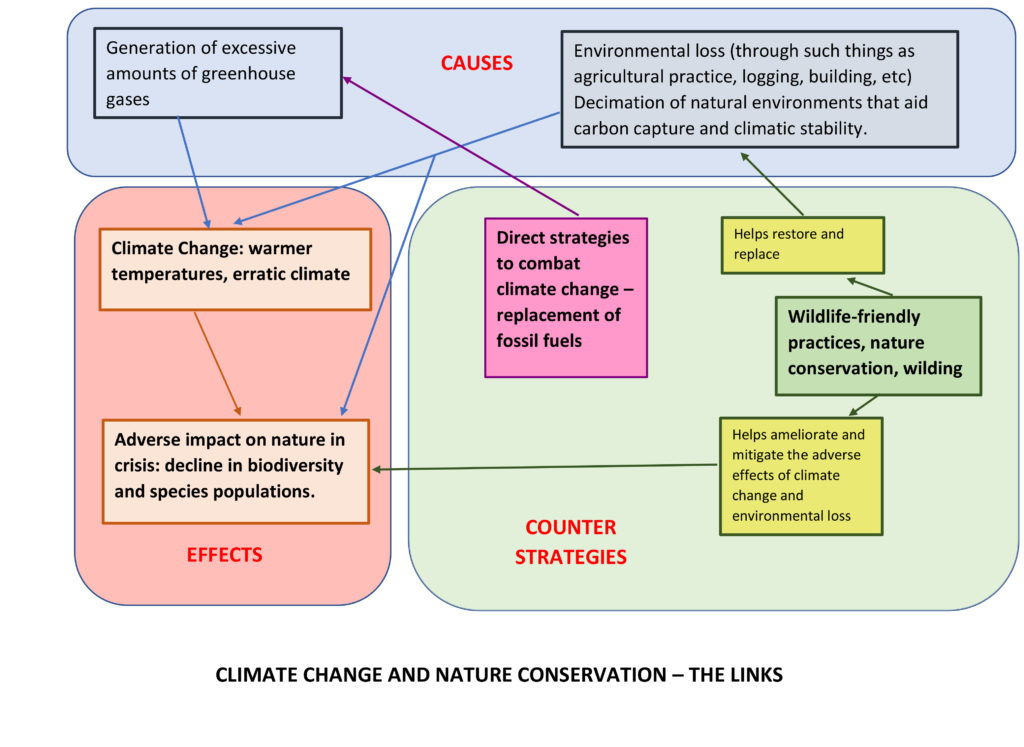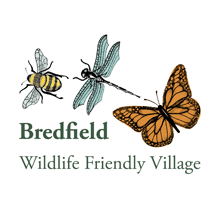A recent climate emergency summit in Woodbridge included a talk by a representative of the Suffolk Wildlife Trust. The talk, which was largely about nature habitats and wilding, was interesting and galvanising, but I noted that that there was no mention of ‘climate change’ in the whole talk. I suspect that the speaker assumed that everyone in the audience knew and could trace the connection between tackling climate change, on the one hand, and nature conservation, on the other. However, I fear that this may be a rather optimistic assumption. When I’ve talked to people about climate change and being wildlife-friendly, I usually get a good response, but I have been asked “how can being wildlife-friendly in my garden, or your garden, help tackle climate change?” A good question, and we shouldn’t assume that everyone can trace the connection between the two. Let’s see if we can connect the two things – climate change and being wildlife-friendly – in a manner that is clear and convincing. First, we need to return to the basics and remind ourselves what is causing current climate change.

Greenhouse gases – carbon dioxide, methane and others – have always been present; always been generated. The crucial point about greenhouse gases is not that they are new, but that they are now present in excessive amounts. The current amount of these gases in the atmosphere is a result of two things: increasing production of these gases (largely through burning fossil fuels) and declining resources for absorbing carbon (forests, cold and nutrient-rich oceans, non-arid soils, etc). The natural balance which made Earth so perfectly habitable (the ‘just right’ Goldilocks effect) is now increasingly out of kilter.
When we talk of ‘declining resources for absorbing carbon’ we are, in large part, referring to the destruction of habitats where nature has previously thrived. Conservation strategies aimed at stopping such environmental damage, or aimed at habitat restoration (such as planting trees), will usually have a positive climate impact in terms of increasing natural resources for carbon sequestration. In this respect, nature conservation is a direct and potent strategy for tackling climate change.
However, other nature conservation strategies may lack, or appear to lack, this direct link to tackling climate change. To take an example close to the heart of what we are trying to do in Bredfield, wildlife-friendly gardening (including feeding birds and planting bee-friendly flowers) is unlikely, in itself, to help the fight against climate change in any direct sense. This doesn’t mean that it is not worth doing, or not worth including in a broad collection of strategies aimed at tackling climate change. The point about being wildlife-friendly, or engaging in nature conservation by any other name, is that it helps ameliorate or mitigate the impact of climate change on the natural environment. Let’s look more closely at this. (You may find the attached diagram helpful in tracing the causal connections.)
Nature is in severe danger. The decline of plant life, invertebrates and vertebrates is now thoroughly researched and well-documented. Of course, not all of this decline is a result of global warming. Much of decline has been caused by environmental loss and chemical pollution (which, as mentioned above, also contribute directly to global warming). However, increasingly warmer temperatures and erratic weather will have an additional adverse impact on nature. Nature has evolved to exist with largely predictable patterns of seasonal change in temperature and rainfall. (Consider the timings of migration, breeding, pupation, hibernation and so on.) When regular climatic patterns are severely disrupted, nature will suffer further. In this catastrophic situation, nature needs all the help we can provide. By providing wildlife-friendly spaces (gardens, woodland, meadows, connected hedgerows, etc) we are helping plants and animals survive under the impact of environmental loss, pollution and climate change. This will not, in itself, reverse climate change (other, industrial and consumer-related changes are needed), but it will certainly help ameliorate or mitigate the impacts of climate change. Put another way, if we do eventually find a lasting solution to climate change, this will not be cause for great celebration if we have already lost so many of our plants, insects, fish, birds and mammals, because we left it too late to help them survive.

So, we must ensure that nature conservation and wildlife-friendly practices form part of any green strategy to tackle climate change. But make clear that, alongside the aim of removing the causes of climate changes, we also need to reduce and ameliorate the impact of climate change on nature – before it is too late.
This article also appeared in the Winter 2022 edition of the East Suffolk Greenprint Forum magazine

